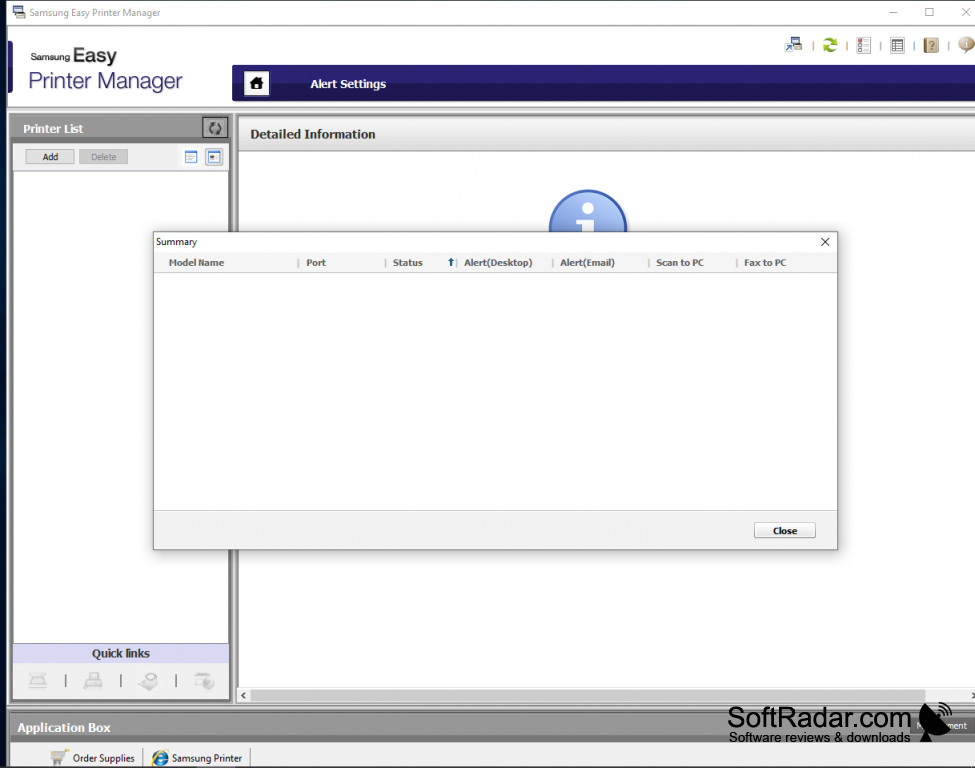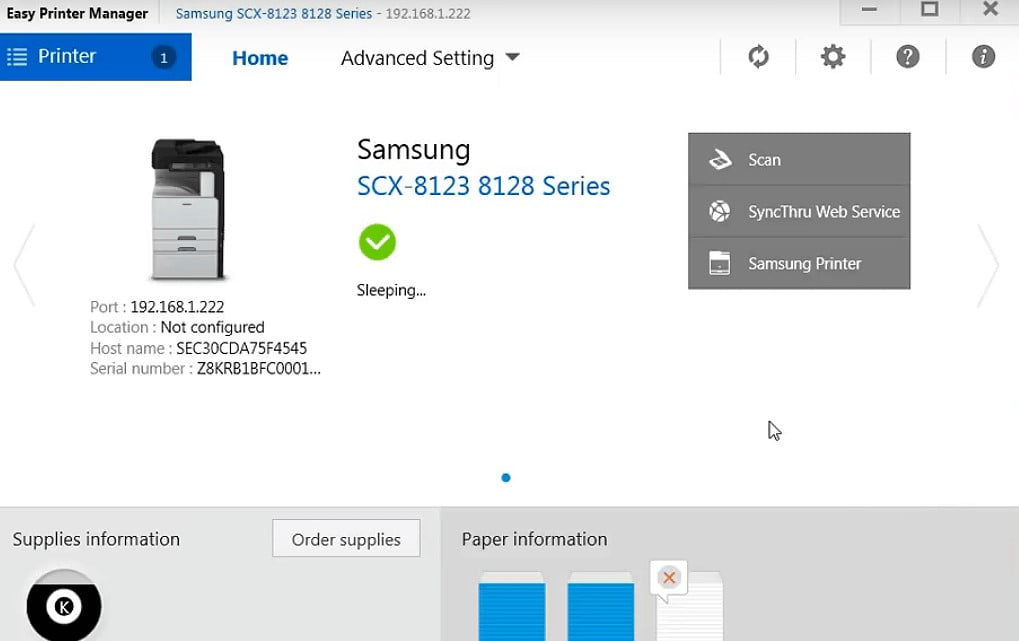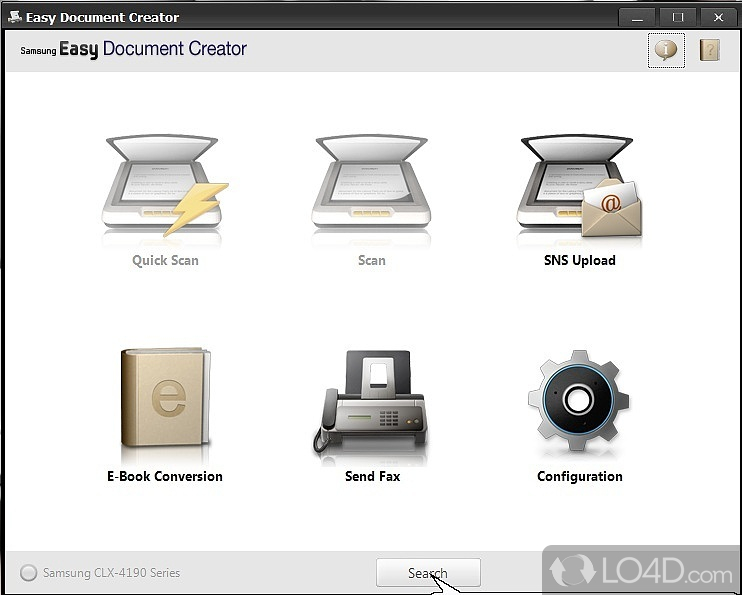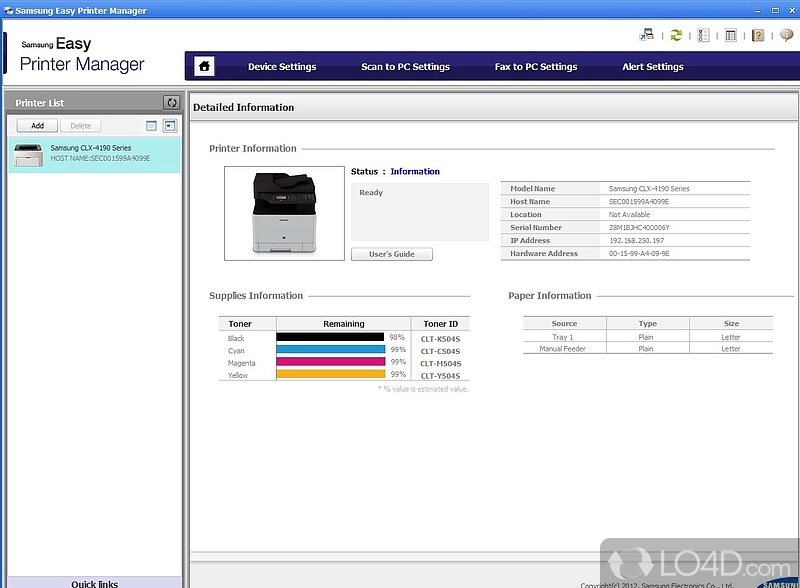When encountering the issue of “Samsung Easy Printer Manager does not scan,” users may experience frustration and confusion. This comprehensive guide delves into the intricacies of the Samsung Easy Printer Manager, providing a detailed analysis of potential causes and effective troubleshooting techniques.
By exploring common scanning issues, connectivity challenges, and software conflicts, we aim to empower users with the knowledge and skills to resolve these problems efficiently, ensuring seamless scanning operations.
Samsung Easy Printer Manager Overview

Samsung Easy Printer Manager is a software application developed by Samsung Electronics that enables users to manage and control their Samsung printers and multifunction devices (MFDs). It provides a comprehensive suite of features designed to simplify printing tasks, enhance productivity, and optimize device performance.
The key features of Samsung Easy Printer Manager include:
- Device Management:Allows users to add, remove, and configure multiple Samsung printers and MFDs on a single platform.
- Printing and Scanning:Facilitates printing and scanning documents, images, and other files directly from the software interface.
- Print Job Management:Enables users to monitor and manage print jobs, including pausing, resuming, canceling, and prioritizing tasks.
- Device Diagnostics:Provides diagnostic tools to identify and troubleshoot printer issues, ensuring optimal performance and reliability.
- Supplies Monitoring:Monitors toner and ink levels, alerting users when supplies need to be replaced to avoid interruptions.
- Customization:Allows users to personalize printer settings, such as paper size, print quality, and duplex printing options.
Troubleshooting Scanning Issues
Samsung Easy Printer Manager may encounter difficulties scanning due to various reasons. This section provides a comprehensive guide to identify and resolve these issues.
Common reasons for scanning issues include:
- Incorrect scanner settings
- Outdated or corrupted drivers
- Physical hardware issues
- Firewall or antivirus software interference
Troubleshooting Steps
To troubleshoot scanning issues, follow these steps:
- Check scanner settings:Ensure that the scanner is properly connected and powered on. Verify that the correct scanner model is selected in Samsung Easy Printer Manager.
- Update drivers:Install the latest drivers for your scanner and Samsung Easy Printer Manager. Outdated drivers can cause compatibility issues.
- Restart scanner and computer:Sometimes, restarting the scanner and computer can resolve temporary glitches.
- Check hardware:Inspect the scanner for any physical damage or obstructions. Clean the scanner glass and rollers to remove debris.
- Disable firewall and antivirus:Temporarily disable firewall and antivirus software to check if they are interfering with scanning.
Advanced Troubleshooting Tips
For more complex scanning issues, consider these advanced troubleshooting tips:
- Check USB connection:Ensure that the scanner is securely connected to the computer using a high-quality USB cable.
- Use a different USB port:Try connecting the scanner to a different USB port on your computer.
- Reinstall Samsung Easy Printer Manager:Uninstall and reinstall Samsung Easy Printer Manager to eliminate any software conflicts.
- Contact Samsung support:If all else fails, contact Samsung support for further assistance.
Troubleshooting Flowchart
Refer to the following flowchart for a visual guide to troubleshooting scanning issues:
[Insert flowchart here]
Connectivity and Communication
Establishing and maintaining proper connectivity and communication between the printer and computer are crucial for successful scanning operations. Various factors can affect connectivity, including physical connections, network settings, and software configurations.
Physical Connection
- Inspect the physical connection between the printer and computer, ensuring that cables are securely plugged into the appropriate ports and that there are no loose connections.
- If using a wireless connection, check the signal strength and proximity to the router.
Network Settings
- Verify the network settings on both the printer and computer to ensure they are on the same network and have valid IP addresses.
- Check if the firewall on the computer is blocking communication with the printer. If necessary, adjust firewall settings to allow traffic from the printer.
Network Connectivity Test
- Ping the printer’s IP address from the computer’s command prompt to test network connectivity.
- If the ping is unsuccessful, check the network hardware, cables, and router configuration.
Printer Firmware
- Update the printer’s firmware to the latest version, as it may contain fixes for connectivity issues.
- Firmware updates can be obtained from the manufacturer’s website.
Printer Logs
- Check the printer’s logs for any error messages related to connectivity.
- These logs may provide insights into the cause of the issue and suggest troubleshooting steps.
Printer Driver Status
The printer driver is a software program that allows your computer to communicate with your printer. If the correct printer driver is not installed or is outdated, you may experience problems scanning.
To determine if the correct printer driver is installed and up-to-date, follow these steps:
- Open the Control Panel.
- Click on “Printers and Faxes”.
- Right-click on your printer and select “Properties”.
- Click on the “Driver” tab.
- The driver version will be listed in the “Driver Version” field.
If the driver is not installed or is outdated, you can download the latest driver from the manufacturer’s website.
To install or update the driver, follow these steps:
- Go to the manufacturer’s website.
- Locate the support section for your printer model.
- Download the latest driver for your operating system.
- Double-click on the downloaded file to install the driver.
- Follow the on-screen instructions to complete the installation.
Once the driver is installed or updated, restart your computer and try scanning again.
Scanner Hardware Issues
Scanning issues can sometimes be attributed to hardware problems with the scanner itself. Identifying and resolving these hardware issues can help restore scanning functionality.
Common hardware issues that may affect scanning include:
- Damaged or loose cables:Ensure that the cables connecting the scanner to the computer are securely plugged in and not damaged.
- Faulty scanner head:The scanner head may be dirty or misaligned, leading to scanning problems. Clean the scanner head using a soft cloth and ensure it is correctly positioned.
- Paper jams:Paper jams can obstruct the scanning process. Check for any paper jams and remove them carefully.
- Defective power supply:A faulty power supply can prevent the scanner from functioning properly. Ensure that the scanner is receiving adequate power.
- Overheating:Excessive heat can cause scanner malfunctions. Allow the scanner to cool down before attempting to scan again.
To troubleshoot hardware issues, follow these steps:
- Check cables and connections:Ensure that all cables are securely connected and not damaged. Replace any faulty cables.
- Clean the scanner head:Use a soft cloth to gently clean the scanner head. Avoid using harsh chemicals or abrasive materials.
- Inspect for paper jams:Open the scanner and carefully remove any jammed paper. Avoid tearing the paper.
- Verify power supply:Ensure that the scanner is plugged into a working power outlet and receiving adequate power.
- Allow cooling:If the scanner is overheating, unplug it and allow it to cool down before attempting to use it again.
If the above troubleshooting steps do not resolve the hardware issue, consult the scanner’s user manual or contact the manufacturer for further assistance.
Software Conflicts: Samsung Easy Printer Manager Does Not Scan

Software conflicts occur when two or more programs attempt to use the same resources, such as memory or hardware, causing interference and affecting the performance of the printer manager.
Identifying software conflicts can be challenging, but there are several methods to approach this issue:
Troubleshooting Software Conflicts
- Check for recently installed software:If the scanning issue started after installing new software, it may be the cause of the conflict.
- Disable non-essential software:Temporarily disable any unnecessary software or programs running in the background to see if the issue persists.
- Use the Task Manager:Open the Task Manager to monitor resource usage and identify any programs consuming excessive resources.
- Check for software updates:Software updates often include bug fixes and compatibility improvements that can resolve software conflicts.
- Contact the software vendor:If you suspect a specific software is causing the conflict, contact the vendor for technical support.
Antivirus and Firewall Settings
Antivirus and firewall software can sometimes block the scanning process. To ensure successful scanning, it is important to examine and adjust the settings of these programs.
Review the following steps to adjust antivirus and firewall settings:
Adjusting Antivirus and Firewall Settings
- Examine antivirus settings:Check the antivirus software’s settings to identify any options related to scanning or network access. Disable or adjust any settings that may be blocking the scanning process.
- Examine firewall settings:Review the firewall settings to ensure that the ports required for scanning are open. Common ports used for scanning include TCP ports 139, 445, and 9100.
- Temporarily disable antivirus and firewall:If necessary, temporarily disable the antivirus and firewall software to allow scanning. Remember to re-enable them after scanning is complete.
Specific Antivirus and Firewall Software
The specific settings that need to be adjusted may vary depending on the antivirus and firewall software used. Consult the software’s documentation or support website for guidance on adjusting settings.
Table of Antivirus and Firewall Settings
The following table provides a summary of the antivirus and firewall settings that may need to be adjusted:
| Antivirus/Firewall Software | Settings to Adjust |
|---|---|
| Windows Defender | – Disable real-time protection
|
| Norton Antivirus | – Disable scanning of network traffic
|
| McAfee Antivirus | – Disable firewall
|
Document Settings
Ensuring that the document settings are compatible with the scanner is crucial for successful scanning. Optimizing these settings can significantly enhance the quality and accuracy of the scanned output.
The document settings include parameters such as resolution, color mode, and file format. These settings should be carefully adjusted to match the specific requirements of the scanning task.
Resolution
Resolution refers to the number of dots per inch (dpi) that the scanner uses to capture the image. A higher resolution results in a more detailed scan, but it also increases the file size. For most general scanning purposes, a resolution of 300 dpi is sufficient.
Color Mode
The color mode determines whether the scanner captures the image in color, grayscale, or black and white. The appropriate color mode depends on the intended use of the scanned image.
File Format
The file format specifies the type of file that the scanned image is saved as. Common file formats include JPEG, PNG, and PDF. The choice of file format depends on factors such as the desired image quality, file size, and compatibility with other software.
Samsung Easy Printer Manager is a comprehensive software suite designed to enhance the functionality of Samsung printers. While it offers a range of features, some users may encounter difficulties with scanning using the software. For users facing such issues, the Samsung Xpress M2875FD Easy Printer Manager provides a dedicated solution.
However, it’s important to note that the Easy Printer Manager remains a valuable tool for managing Samsung printers, offering features such as driver updates, printer status monitoring, and advanced scanning options.
Scanning to Different Destinations
Scanning to different destinations allows you to send scanned documents directly to email addresses, cloud storage services, or other designated locations. This feature is convenient for sharing or storing scanned documents without having to manually save and transfer them.To configure scanning destinations in Samsung Easy Printer Manager:
- Open Samsung Easy Printer Manager.
- Select the desired printer from the list of available devices.
- Click on the “Scan” tab.
- Under “Destination,” click on the “Add” button.
- Choose the destination type (e.g., email, cloud storage) and follow the on-screen instructions to configure the destination.
Once you have configured the scanning destinations, you can select the desired destination when initiating a scan. This will automatically send the scanned document to the specified location.
Advanced Troubleshooting Techniques

Advanced troubleshooting techniques can be employed to resolve complex scanning issues that cannot be resolved using basic troubleshooting methods. These techniques involve using diagnostic tools and logs to analyze the scanning process and identify the root cause of the issue.
Diagnostic Tools and Logs
Diagnostic tools and logs provide valuable information about the scanning process and can help identify errors or problems. Some common diagnostic tools and logs include:
Scanner logs
Scanner logs record events and errors that occur during the scanning process. They can be accessed through the scanner’s control panel or software.
Printer logs
Printer logs record events and errors that occur during the printing process. They can be accessed through the printer’s control panel or software.
Event logs
Event logs record events that occur on the computer, including errors and warnings. They can be accessed through the Windows Event Viewer.
Interpreting Diagnostic Tools and Logs, Samsung easy printer manager does not scan
The output of diagnostic tools and logs can be complex and difficult to interpret. However, there are some general guidelines that can help you identify the root cause of scanning issues:
Look for error messages
Error messages will often provide a clear indication of the problem.
Examine the timestamps
The timestamps of events can help you determine the sequence of events and identify the point at which the issue occurred.
Correlate events
Correlating events from different diagnostic tools and logs can help you identify the cause-and-effect relationship between events.
Resolving Common Scanning Issues Using Advanced Troubleshooting Techniques
Advanced troubleshooting techniques can be used to resolve a variety of common scanning issues, including:
Scanner not detected
This issue can be caused by a variety of factors, including loose cables, incorrect driver installation, or hardware problems.
Scanner not scanning
This issue can be caused by a variety of factors, including incorrect settings, document feeder problems, or software conflicts.
Scanned images are distorted or blurry
This issue can be caused by a variety of factors, including incorrect resolution settings, dirty scanner glass, or hardware problems.
User Interface and Navigation
The Samsung Easy Printer Manager features a user-friendly interface designed for intuitive navigation and easy access to scanning functions.
Upon launching the software, users are presented with a dashboard displaying a list of connected printers and a set of quick-access options. The menu bar at the top of the interface provides navigation to different sections of the software, including the scanning module.
Navigating Scanning Features
To initiate a scan, users can click on the “Scan” button located on the dashboard or select the “Scan” option from the menu bar. This opens the scanning module, where users can configure scanning settings and preview the scanned document before saving it.
The scanning module offers a range of options for customizing the scan, including document size, resolution, color mode, and file format. Users can also select the destination folder where the scanned document will be saved.
Troubleshooting with HTML Tables

This HTML table summarizes common scanning issues and their solutions, providing clear explanations, severity levels, and step-by-step resolution instructions.
The table is styled using CSS for clarity and readability, making it easy to identify and resolve scanning problems.
Scanning Issues and Solutions Table
| Issue | Severity | Resolution |
|---|---|---|
| Scanner not detected | Critical | – Check if the scanner is properly connected to the computer and powered on.
|
| Scanned image is blurry or distorted | Moderate | – Clean the scanner glass and document feeder.
|
| Scanner software is not responding | Moderate | – Close and restart the scanner software.
|
| Scanned image is too dark or too light | Minor | – Adjust the scanner brightness settings.
|
| Scanner is making strange noises | Critical | – Stop using the scanner and contact technical support.
|
Troubleshooting Scanning Issues
Scanning issues can arise due to various factors. Troubleshooting these issues requires a systematic approach to identify and resolve the root cause.
The following steps can help troubleshoot scanning issues:
- Check the physical connection:Ensure that the scanner is properly connected to the computer via USB or wireless network.
- Restart the scanner and computer:A simple restart can often resolve temporary glitches or software conflicts.
- Update scanner drivers:Outdated drivers can cause compatibility issues. Check for and install the latest drivers from the manufacturer’s website.
- Check scanner hardware:Inspect the scanner for any physical damage or obstructions. Clean the scanner glass and document feeder if necessary.
- Disable antivirus and firewall:Antivirus software and firewalls can sometimes block scanner communication. Temporarily disable these programs to test if they are causing the issue.
- Check document settings:Ensure that the document is placed correctly on the scanner glass or in the document feeder. Adjust the scan settings (resolution, color mode, etc.) as needed.
- Try scanning to different destinations:Attempt to scan to multiple destinations (e.g., computer, email, cloud storage) to determine if the issue is specific to a particular destination.
- Perform advanced troubleshooting:If the basic steps do not resolve the issue, consider using advanced troubleshooting techniques such as checking event logs, using diagnostic tools, or contacting technical support.
Troubleshooting Scanning Issues Summary Table
| Step | Description |
|---|---|
| 1 | Check physical connection |
| 2 | Restart scanner and computer |
| 3 | Update scanner drivers |
| 4 | Check scanner hardware |
| 5 | Disable antivirus and firewall |
| 6 | Check document settings |
| 7 | Try scanning to different destinations |
| 8 | Perform advanced troubleshooting |
Note:If the scanning issue persists after following these steps, contact the scanner manufacturer or technical support for further assistance.
Illustrating Error Messages
Error messages related to scanning issues can provide valuable information about the cause of the problem. Here are some common error messages and their explanations:
Scanner not found
- The scanner is not connected to the computer or is not turned on.
- The scanner driver is not installed or is not working properly.
Scanning failed
- The original document is not placed correctly on the scanner bed.
- The scanner is experiencing a hardware issue.
- There is a software conflict or antivirus/firewall setting that is blocking the scanning process.
Scanned image is distorted or has poor quality
- The scanner settings are not configured correctly for the type of document being scanned.
- The scanner is dirty or damaged.
- The original document is damaged or of poor quality.
Cannot save the scanned image
- The destination folder does not have enough space.
- The file format selected for saving the scanned image is not supported.
- There is a problem with the software or operating system that is preventing the file from being saved.
Case Studies and Real-World Examples
This section provides case studies and real-world examples of scanning issues resolved using the troubleshooting methods discussed in this document.
Resolved Scanning Issue 1
Problem:A user was unable to scan documents from their Samsung printer using the Samsung Easy Printer Manager software. The scanner hardware appeared to be working correctly, but the software was not detecting the scanner.
Solution:The issue was resolved by updating the Samsung Easy Printer Manager software to the latest version. The updated software included a fix for a bug that was preventing the software from detecting the scanner.
If you’re experiencing issues with Samsung Easy Printer Manager not scanning, consider checking the settings of the Samsung Printer Easy Colour Manager. This tool allows for advanced colour management and may affect the scanning process. Once you’ve verified the colour settings, return to Samsung Easy Printer Manager and attempt to scan again to determine if the issue has been resolved.
Results:After updating the software, the user was able to scan documents from their printer using the Samsung Easy Printer Manager software without any problems.
Resolved Scanning Issue 2
Problem:A user was experiencing scanning issues with their Samsung printer. The printer was connected to the computer via a USB cable, but the computer was not recognizing the scanner.
Solution:The issue was resolved by reinstalling the printer driver. The user uninstalled the existing printer driver and then downloaded and installed the latest driver from the Samsung website.
Results:After reinstalling the printer driver, the computer was able to recognize the scanner and the user was able to scan documents without any problems.
Final Wrap-Up

In conclusion, troubleshooting scanning issues with Samsung Easy Printer Manager requires a systematic approach that addresses various potential causes. By understanding the common pitfalls, connectivity requirements, software conflicts, and document settings, users can effectively diagnose and resolve these issues. The troubleshooting techniques Artikeld in this guide provide a comprehensive roadmap for users to regain optimal scanning functionality, enabling them to capture and digitize documents with ease.
FAQ Summary
Why is my Samsung printer not scanning?
There could be several reasons, including connectivity issues, outdated drivers, software conflicts, or hardware problems.
How do I fix Samsung Easy Printer Manager scanning issues?
Start by checking physical connections, updating drivers, and resolving any software conflicts. If the issue persists, consider hardware troubleshooting or advanced techniques.
What are common connectivity issues with Samsung printers?
Connectivity issues can arise due to loose cables, incorrect network settings, firewall restrictions, or outdated firmware.
